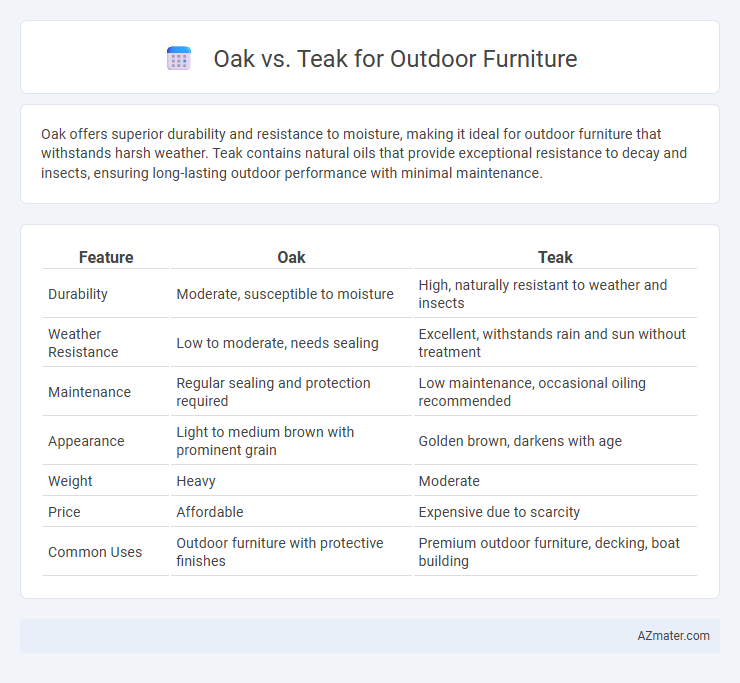Oak offers superior durability and resistance to moisture, making it ideal for outdoor furniture that withstands harsh weather. Teak contains natural oils that provide exceptional resistance to decay and insects, ensuring long-lasting outdoor performance with minimal maintenance.
Table of Comparison
| Feature | Oak | Teak |
|---|---|---|
| Durability | Moderate, susceptible to moisture | High, naturally resistant to weather and insects |
| Weather Resistance | Low to moderate, needs sealing | Excellent, withstands rain and sun without treatment |
| Maintenance | Regular sealing and protection required | Low maintenance, occasional oiling recommended |
| Appearance | Light to medium brown with prominent grain | Golden brown, darkens with age |
| Weight | Heavy | Moderate |
| Price | Affordable | Expensive due to scarcity |
| Common Uses | Outdoor furniture with protective finishes | Premium outdoor furniture, decking, boat building |
Introduction to Oak and Teak for Outdoor Furniture
Oak and teak are two of the most popular hardwoods used in outdoor furniture due to their durability and weather resistance. Oak is known for its dense grain and strength, making it highly resistant to wear and decay, while teak contains natural oils that protect it from moisture, insects, and UV damage. Both woods require minimal maintenance and develop a desirable patina over time, enhancing the aesthetic appeal of patio sets, benches, and garden furniture.
Durability: Oak vs Teak in Outdoor Conditions
Teak wood possesses exceptional durability in outdoor conditions due to natural oils that resist moisture, decay, and insect damage, making it ideal for long-lasting outdoor furniture. Oak, while strong and dense, tends to absorb moisture and is more prone to rot and warping without proper sealing and maintenance. Teak's superior resistance to weathering and minimal upkeep requirements generally outperform oak in outdoor durability.
Weather Resistance Comparison: Oak vs Teak
Teak wood outperforms oak in weather resistance due to its natural oils and dense grain, which provide exceptional protection against moisture, rot, and insect damage. Oak, while strong and durable, is more susceptible to water absorption, leading to potential warping and decay if not properly sealed and maintained. Teak's inherent ability to withstand harsh outdoor conditions with minimal upkeep makes it the preferred choice for outdoor furniture exposed to variable weather.
Maintenance Requirements for Oak and Teak
Oak outdoor furniture requires regular sealing or staining every 1-2 years to prevent moisture damage and maintain its durability, as it is more prone to warping and cracking when exposed to harsh weather conditions. Teak furniture demands less frequent maintenance due to its natural oils, which provide excellent resistance to rot, insects, and moisture, often needing only annual cleaning and occasional oiling to preserve its rich golden color. Proper maintenance of oak involves more effort to protect against decay, while teak's inherent weather-resistant properties make it a low-maintenance choice for outdoor settings.
Appearance and Aesthetic Differences
Oak outdoor furniture features a light to medium brown color with prominent grain patterns that create a classic, rustic aesthetic, while teak offers a rich golden to deep brown hue with smoother, finer grain, imparting a sleek, tropical elegance. Oak's natural texture and tendency to develop a silver-gray patina over time add a weathered charm, whereas teak resists weathering and maintains its warm tone longer due to high natural oil content. The distinct visual characteristics make oak ideal for traditional or farmhouse styles, while teak suits modern and coastal designs, enhancing the overall aesthetic appeal in outdoor settings.
Cost Comparison: Oak vs Teak Outdoor Furniture
Oak outdoor furniture typically costs less than teak due to its more abundant availability and faster growth rate, making it a budget-friendly option for durable wood. Teak, known for its natural oils and resistance to weather and pests, commands a higher price but offers superior longevity and minimal maintenance over time. When comparing costs, oak requires regular sealing and treatment, potentially increasing long-term expenses, whereas teak's initial premium price may offset future upkeep costs.
Sustainability and Environmental Impact
Oak and teak differ significantly in sustainability and environmental impact for outdoor furniture. Oak is a fast-growing hardwood native to temperate regions, making it more renewable with lower carbon emissions during harvesting and processing. Teak, primarily sourced from tropical rainforests, has slower growth and is often associated with deforestation and habitat loss unless certified by organizations like FSC, emphasizing the importance of sustainable sourcing for ecological preservation.
Weight and Workability: Oak vs Teak
Oak is heavier and denser than teak, making outdoor furniture more robust but harder to move and work with during construction. Teak's lighter weight and natural oils enhance workability, allowing easier cutting, shaping, and finishing while providing excellent resistance to outdoor elements. Oak requires more effort for machining and finishing due to its hardness, whereas teak offers smooth handling and durability ideal for intricate furniture designs.
Best Use Cases for Oak and Teak Outdoors
Oak excels in outdoor furniture applications where durability and resistance to wear are essential, particularly in climates with moderate moisture, making it ideal for garden benches and patio dining sets. Teak's natural oils and high silica content provide superior resistance to water, decay, and insects, positioning it as the best choice for outdoor furniture exposed to harsh weather conditions such as poolside lounges and marine environments. Oak offers a cost-effective, sturdy option with a rustic appearance, while teak delivers unmatched longevity and low maintenance for premium outdoor settings.
Final Verdict: Choosing Between Oak and Teak for Outdoor Furniture
Teak offers superior natural oil content and resin, making it highly resistant to moisture, insects, and decay, ideal for long-lasting outdoor furniture. Oak, especially white oak, provides strong durability and a classic appearance but requires regular sealing to prevent water damage and maintain its integrity. For outdoor furniture, teak is generally favored for minimal maintenance and longevity, while oak offers a cost-effective option with proper care.

Infographic: Oak vs Teak for Outdoor Furniture
 azmater.com
azmater.com